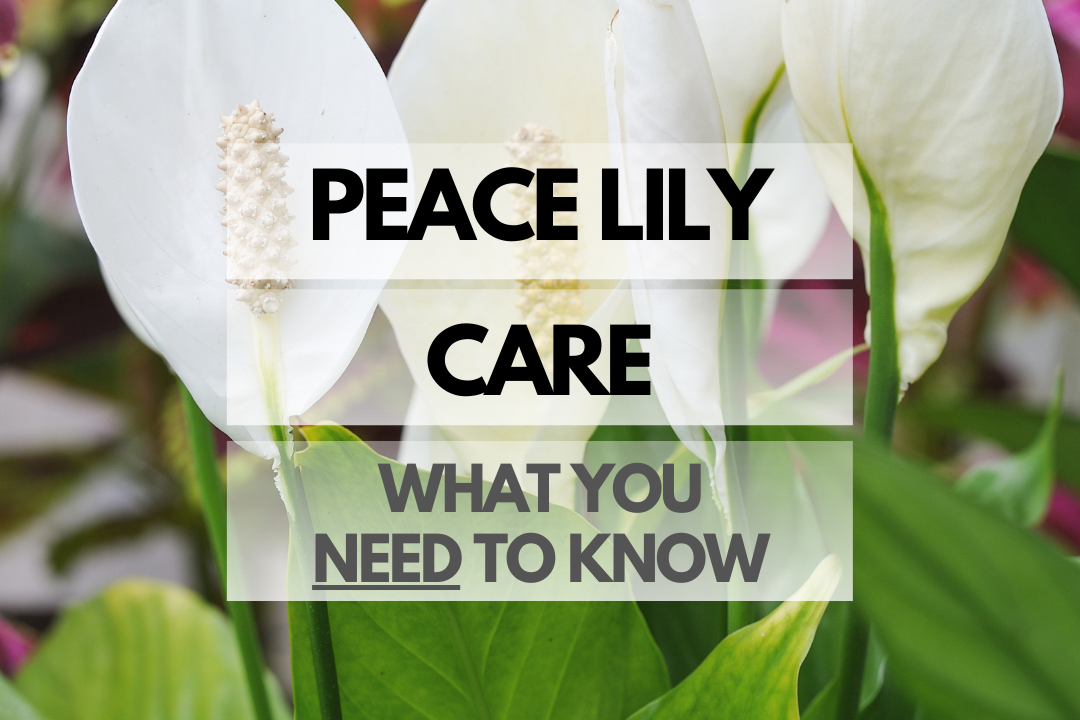Peace Lilies are beautiful and popular houseplants that are known for their striking white flowers and lush green foliage. They also boast air-purifying properties, making them an excellent addition to any indoor space. In this article, we’ll walk you through everything you need to know about Peace Lily care, so you can enjoy this stunning plant in your home.
Peace Lily Care Guide
Quick Reference Table: Caring for Peace Lilies
| Aspect | Peace Lily Care |
|---|---|
| Sunlight | Bright, indirect light; can tolerate low light conditions |
| Soil | Well-draining, peat-based potting mix |
| Watering | Keep soil evenly moist, but not soggy; water less frequently in winter |
| Temperature | 65-80°F (18-27°C) |
| Pruning | Remove dead leaves and spent flowers regularly to encourage new growth |
| Common Problems | Brown leaf tips, yellow leaves, pests (such as spider mites and mealybugs) |
Peace Lily Sunlight: Do They Need It and How Much?
Peace Lilies prefer bright, indirect light but can tolerate lower light conditions. Direct sunlight can cause the leaves to scorch and turn brown, so it’s best to place your Peace Lily in a spot where it will receive filtered or dappled light. If your Peace Lily is not producing flowers, it may need more light.
Peace Lily Soil Tips
Peace Lilies thrive in a well-draining, peat-based potting mix. A mix of one part peat moss and one part perlite is a good choice, as it will retain moisture without becoming waterlogged. Be sure to repot your Peace Lily every 1-2 years to refresh the soil and provide room for growth.
Peace Lily Watering and Frequency
Water your Peace Lily regularly to keep the soil evenly moist but not soggy. It’s essential to avoid overwatering, as this can lead to root rot. Peace Lilies are sensitive to chlorine and fluoride in tap water, so using filtered or rainwater is recommended. During the winter months, reduce your watering frequency, allowing the top inch of soil to dry out between waterings.
Pruning Peace Lilies Properly
Prune your Peace Lily regularly to remove dead leaves and spent flowers. This will encourage new growth and help maintain the plant’s appearance. Use clean, sharp scissors or pruning shears to make a clean cut close to the base of the leaf or flower stem.
Optimal Peace Lily Temperature: Can They Tolerate the Cold?
Peace Lilies prefer temperatures between 65-80°F (18-27°C) and do not tolerate cold drafts or temperatures below 45°F (7°C). Keep your Peace Lily away from drafty windows, air conditioning vents, and heaters to ensure a stable temperature and prevent stress on the plant.
Common Peace Lily Problems
Brown Leaf Tips
Brown leaf tips on Peace Lilies can be caused by several factors, such as underwatering, over-fertilization, or exposure to direct sunlight. To prevent this issue, ensure your watering and fertilization practices are appropriate for the plant’s needs and provide proper lighting conditions.
Yellow Leaves
Yellow leaves can be a sign of overwatering or poor drainage. To avoid this problem, ensure your pot has drainage holes and use a well-draining potting mix. Additionally, adjust your watering frequency to prevent soggy soil.
Pests
Peace Lilies can be susceptible to pests such as spider mites and mealybugs. Regularly inspect your plant for signs of pests, and treat any infestations promptly with insecticidal soap or neem oil.
Peace Lily Outdoors vs Indoors
Peace Lilies can be grown both indoors and outdoors, but they are primarily grown as indoor plantsdue to their preference for stable temperatures and indirect sunlight. Here’s a list of pros and cons for indoor and outdoor growth:
| Location | Pros | Cons |
|---|---|---|
| Indoors |
|
|
| Outdoors |
|
|
Best Pots for Peace Lilies
When choosing a pot for your Peace Lily, look for one with drainage holes to prevent waterlogging. Ceramic or terracotta pots are ideal, as they allow excess moisture to evaporate through the porous material. However, plastic pots can also be used if proper drainage is maintained. Select a pot that is slightly larger than the root ball of your plant, allowing room for growth. Repot your Peace Lily every 1-2 years to refresh the soil and provide additional space for the roots.
Peace Lily Facts
Peace Lily Benefits
- Air Purification: Peace Lilies are known to remove harmful toxins from the air, such as formaldehyde, benzene, and ammonia, improving indoor air quality.
- Aesthetic Appeal: With their elegant white flowers and lush green foliage, Peace Lilies make a beautiful addition to any indoor space, creating a calming and refreshing atmosphere.
- Low Maintenance: Peace Lilies are relatively easy to care for, making them a popular choice for both novice and experienced plant enthusiasts.
Growth Rates: How Fast Do They Grow?
Peace Lilies generally have a moderate growth rate, with new leaves and flowers appearing throughout the growing season (spring and summer). Under optimal conditions, a Peace Lily can grow up to 1-2 feet (30-60 cm) each year. However, growth rates can vary depending on factors such as lighting, temperature, and overall care.
Peace Lily Lifespan
With proper care, Peace Lilies can live for several years, often reaching full maturity at around 5 years. Regular repotting, pruning, and maintaining optimal growing conditions can help extend the lifespan of your Peace Lily.
Are Peace Lilies Safe?
Peace Lilies are toxic to humans and pets if ingested. They contain calcium oxalate crystals, which can cause irritation to the mouth, throat, and gastrointestinal tract. It’s essential to keep Peace Lilies out of reach of children and pets to prevent accidental ingestion.
Peace Lily Flowers
Peace Lily flowers consist of a single white spathe (a modified leaf) surrounding a central spadix (a spike of tiny flowers). The blooms can last for several weeks and typically appear during the spring and summer months. Providing adequate light and maintaining proper care can encourage your Peace Lily to produce more flowers.
Peace Lily Types and Varieties
Spathiphyllum wallisii
This is the most common variety of Peace Lily and features glossy green leaves with white, sail-shaped spathes. It typically grows up to 2-3 feet (60-90 cm) tall and wide.
Spathiphyllum ‘Sensation’
‘Sensation’ is a large variety of Peace Lily that can grow up to 4-6 feet (120-180 cm) tall and wide. It has dark green, ribbed leaves and produces striking white flowers.
Spathiphyllum ‘Domino’
‘Domino’ is a variegated Peace Lily with dark green leaves marbled with white. It has a more compact growth habit, reaching up to 2 feet (60 cm) in height.
Spathiphyllum ‘Moondust’
‘Moondust’ is a compact variety of Peace Lily with silver-green leaves and white flowers. It grows up to 1-2 feet (30-60 cm) tall and wide, making it suitable for smaller spaces.
Peace Lily Pros and Cons
| Pros | Cons |
|---|---|
|
|
Peace Lily Cost
The cost of a Peace Lily can vary depending on factors such as size, variety, and the quality of the plant. On average, you can expect to pay between $10 and $30 for a Peace Lily. Larger or more unusual varieties may cost more.
Where to Buy Peace Lilies
Peace Lilies are widely available at garden centers, nurseries, and online plant retailers. When purchasing a Peace Lily, make sure to choose a healthy plant with lush green foliage and no signs of pests or diseases.
Is Peace Lily Propagation in Water Possible?
Yes, Peace Lily propagation in water is possible and relatively easy. To propagate a Peace Lily in water, carefully remove a healthy, mature plantlet (a small offshoot) from theparent plant, making sure it has some roots attached. Place the plantlet in a container with fresh water, ensuring that the roots are submerged, and change the water regularly to prevent bacterial growth. Once the plantlet has developed a more extensive root system, you can transplant it to a pot with well-draining soil.
Additional Resources
- Missouri Botanical Garden: Spathiphyllum
- GardenWeb Peace Lily Forum
- Peace Lily Enthusiasts Facebook Group
- Peace Lilies: A Complete Guide by Ann Bonar
FAQ for Peace Lily Care
Are Peace Lilies toxic to cats?
Yes, Peace Lilies are toxic to cats. Ingesting any part of the plant can cause irritation, vomiting, and difficulty swallowing. If you suspect your cat has ingested a Peace Lily, contact your veterinarian immediately.
Are Peace Lilies toxic to dogs?
Yes, Peace Lilies are toxic to dogs. Ingesting any part of the plant can cause irritation, vomiting, and difficulty swallowing. If you suspect your dog has ingested a Peace Lily, contact your veterinarian immediately.
Are Peace Lilies toxic to kids?
Yes, Peace Lilies are toxic to humans, including children. Ingesting any part of the plant can cause irritation, vomiting, and difficulty swallowing. Keep Peace Lilies out of reach of children to prevent accidental ingestion.
How tall do Peace Lilies get?
Depending on the variety, Peace Lilies can grow anywhere from 1 to 6 feet (30-180 cm) tall. To maintain a manageable size, regular pruning and repotting are necessary.
Can Peace Lilies live outside?
Peace Lilies are tropical plants and can only live outside in areas with consistently warm temperatures (USDA zones 10-12). In colder climates, they should be grown as indoor plants to protect them from frost and extreme temperature fluctuations.
Are Peace Lilies poisonous?
Yes, Peace Lilies are poisonous to humans and pets due to the presence of calcium oxalate crystals. Ingesting any part of the plant can cause irritation, vomiting, and difficulty swallowing. Keep Peace Lilies out of reach of children and pets to prevent accidental ingestion.
How often should I water my Peace Lily?
Water your Peace Lily when the top inch (2.5 cm) of soil feels dry to the touch. Overwatering can lead to root rot, while underwatering can cause the leaves to wilt and turn brown. It’s essential to find a balance and adjust your watering schedule according to the needs of your plant.

